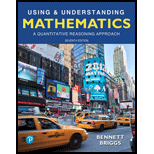
Concept explainers
Part a:
The mean, median, and range for each of the two data sets for the given table which gives average sales tax rate in six east coast and six western states.
Part b:
The five-number summary and draw a box plot for each of the two data sets for the given table which gives average sales tax rate in six east coast and six western states.
| East coast states | Western states | ||
| Florida | 6.8% | California | 8.25% |
| Massachusetts | 6.25% | Arkansas | 1.76% |
| Maryland | 6.00% | Oregon | 0% |
| New Hampshire | 0% | Washington | 8.92% |
| New York | 8.49% | Arizona | 8.25% |
| Rhode Island | 7.00% | Utah | 6.76% |
Refer explanation.
Part c:
The standard deviation for each of the two data sets for the given table which gives average sales tax rate in six east coast and six western states.
| East coast states | Western states | ||
| Florida | 6.8% | California | 8.25% |
| Massachusetts | 6.25% | Arkansas | 1.76% |
| Maryland | 6.00% | Oregon | 0% |
| New Hampshire | 0% | Washington | 8.92% |
| New York | 8.49% | Arizona | 8.25% |
| Rhode Island | 7.00% | Utah | 6.76% |
Part d:
The standard deviation for each of the two data sets using range rule of thumb for the given table which gives average sales tax rate in six east coast and six western states.
| East coast states | Western states | ||
| Florida | 6.8% | California | 8.25% |
| Massachusetts | 6.25% | Arkansas | 1.76% |
| Maryland | 6.00% | Oregon | 0% |
| New Hampshire | 0% | Washington | 8.92% |
| New York | 8.49% | Arizona | 8.25% |
| Rhode Island | 7.00% | Utah | 6.76% |
Part e:
To compare: The two data sets in terms of their center and variation for the given table which gives average sales tax rate in six east coast and six western states.
| East coast states | Western states | ||
| Florida | 6.8% | California | 8.25% |
| Massachusetts | 6.25% | Arkansas | 1.76% |
| Maryland | 6.00% | Oregon | 0% |
| New Hampshire | 0% | Washington | 8.92% |
| New York | 8.49% | Arizona | 8.25% |
| Rhode Island | 7.00% | Utah | 6.76% |
The average of sales tax rate in east coast states and western states are almost same. Variation is more in western states.
Trending nowThis is a popular solution!

Chapter 6 Solutions
Pearson eText for Using & Understanding Mathematics: A Quantitative Reasoning Approach -- Instant Access (Pearson+)
- A research team consists of 4 senior researchers and 10 research assistants. The team needs to select 2 senior researchers and 2 research assistants to attend a conference. How many different ways can the group being sent to the conference be formed?arrow_forwardThere are 25 different varieties of flowering plants found in a natural habitat you are studying. You are asked to randomly select 5 of these flowering plant varieties to bring back to your laboratory for further study. How many different combinations of are possible? That is, how many possible 5 plant subgroups can be formed out of the 25 total plants found?arrow_forwardA person is tossing a fair, two-sided coin three times and recording the results (either a Heads, H, or a Tails, T). Let E be the event that exactly two heads are tossed. Which of the following sets represent the event E? Group of answer choices {HHT, HTH, THH} {HHT, THH} {HHH, HHT, HTH, THH, TTT, TTH, THT, HTT} {HH}arrow_forward
- Take Quiz 54m Exit Let the universal set be whole numbers 1 through 20 inclusive. That is, U = {1, 2, 3, 4, . . ., 19, 20}. Let A, B, and C be subsets of U. Let A be the set of all prime numbers: A = {2, 3, 5, 7, 11, 13, 17, 19} Let B be the set of all odd numbers: B = {1,3,5,7, • • , 17, 19} Let C be the set of all square numbers: C = {1,4,9,16} ☐ Question 2 3 pts Which of the following statement(s) is true? Select all that apply. (1) АСВ (2) A and C are disjoint (mutually exclusive) sets. (3) |B| = n(B) = 10 (4) All of the elements in AC are even numbers. ☐ Statement 1 is true. Statement 2 is true. Statement 3 is true. Statement 4 is true.arrow_forward☐ Question 1 2 pts Let G be the set that represents all whole numbers between 5 and 12 exclusive. Which of the following is set G in standard set notation. (Roster Method)? O G = [5, 12] G = {5, 6, 7, 8, 9, 10, 11, 12} O G = (5, 12) OG = {6, 7, 8, 9, 10, 11}arrow_forwardSolve 11.23arrow_forward
 Discrete Mathematics and Its Applications ( 8th I...MathISBN:9781259676512Author:Kenneth H RosenPublisher:McGraw-Hill Education
Discrete Mathematics and Its Applications ( 8th I...MathISBN:9781259676512Author:Kenneth H RosenPublisher:McGraw-Hill Education Mathematics for Elementary Teachers with Activiti...MathISBN:9780134392790Author:Beckmann, SybillaPublisher:PEARSON
Mathematics for Elementary Teachers with Activiti...MathISBN:9780134392790Author:Beckmann, SybillaPublisher:PEARSON
 Thinking Mathematically (7th Edition)MathISBN:9780134683713Author:Robert F. BlitzerPublisher:PEARSON
Thinking Mathematically (7th Edition)MathISBN:9780134683713Author:Robert F. BlitzerPublisher:PEARSON Discrete Mathematics With ApplicationsMathISBN:9781337694193Author:EPP, Susanna S.Publisher:Cengage Learning,
Discrete Mathematics With ApplicationsMathISBN:9781337694193Author:EPP, Susanna S.Publisher:Cengage Learning, Pathways To Math Literacy (looseleaf)MathISBN:9781259985607Author:David Sobecki Professor, Brian A. MercerPublisher:McGraw-Hill Education
Pathways To Math Literacy (looseleaf)MathISBN:9781259985607Author:David Sobecki Professor, Brian A. MercerPublisher:McGraw-Hill Education





